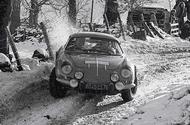Jean-Luc Thérier braves the Britishm winter of 1970
Our testers get behind the wheel of a just-overhauled, semi-works A110 1600 S by Brit Nigel Hollier
“I had the most fun when I was zipping around the Alps in my Renault 4CV. I therefore decided to call my future cars ‘Alpine’. My customers had to find this same pleasure at the wheel of the car I wanted to build,” said Jean Rédélé.
The reason why this 28-year-old man from Normandy was having such fun way down south was not because he was taking his young family on holiday; it was because, in his job as a Renault dealer, he had entered this novel economy saloon into the 1950 Monte Carlo Rally, reasoning: “Racing is the best way to test production cars and victory is the best sales tool.”
Rédélé won at just his second attempt, which spurred him on to enhance his bosses’ wares – and he eventually found a firm to create sports cars using Renault parts. Skip forward two decades and we find Alpine as a well-known name with victories in virtually every French national rally and hillclimb event, plus in some major foreign circuit races.
Autocar Archive returns: 128 years of magazines available online
This strong record was largely thanks to the A110, a miniature ‘berlinette’ introduced in 1962 and continually improved thereafter.
When the FIA collated the world’s seven most significant rallies to create the International Championship for Manufacturers (IMS), Alpine was of course most keen. The A110 came second in the first season of 1970, losing to the Porsche 911 by just two points.
Not long after, Autocar was given the chance to try a just-overhauled, semi-works A110 1600 S by Brit Nigel Hollier (who had retired from the recent RAC Rally, which had been won by a Lancia Fulvia).
“We don’t normally start a description of a competition car with seemingly sensationalist paragraphs about noise, but one has to with the Alpine,” reported our Michael Scarlett.
“When you realise that, most unfortunately, the [silencer] valve has stuck in the straight-through position and will remain so, the monstrous chortle of this waspish little coupé is the last thing that impresses you, too.
“Its performance is undoubted. The four-cylinder pushrod engine is basically the Renault 16 TS unit but somewhat modified – bigger inlet valves with 0.3in lift, very different valve timing, an 11.25 compression ratio and two big Weber carburettors. It shows 154bhp at 6800rpm on the brake, with 125lb ft at 5300rpm [over 83bhp and 87lb ft in the R16].”
Mechanical sympathy stopped us from slipping the clutch and revving high for the best times, but “as it was, 60mph came up in 8.8sec and 100mph in 27.1sec – pretty creditable times for a 1.6”.
“Driven normally [rather than always sideways], one finds the Alpine’s rack-and-pinion steering delightfully accurate and pretty high-geared, with [it] possessed of surprisingly good straight stability.
“We were pleasantly surprised to find that the ride is remarkably good, particularly for a rally car, although wheel movements do not look small. They are not small enough to avoid changes of camber on cornering hard on dry Tarmac, so that, coupled with the rear heaviness, the tail will go out most dramatically if you lift off at all.
Go in to the bend fairly fast, then apply power and the car stays virtually dead neutral assuming you’re still on [quality Tarmac].
Turn into a slippery side road reasonably modestly and apply power and such is the tremendous traction of the loudly clonking limited-slip diff rear that you can easily break away the front tyres momentarily.
“I can imagine that, on loose stuff where niceties of tyre angle to road surface are largely immaterial, because the surface is never drawing board-even, a brave man can do largely what he wants: use the traction, which has certainly been the Alpine’s great advantage in snowy rallies, or tail-slide to choice.
“Having played with this one in the wide-open spaces of MIRA and found it all too easy to slide but not so easy to slide exactly where you want, I think Alpine drivers are braver than most rally types.”
Thankfully for them, bravery equalled success rather than disaster, as Alpine won the 1971 IMC title – and the first World Rally Championship of 1973.
If only four-wheel drive weren’t needed to win rallies these days…







